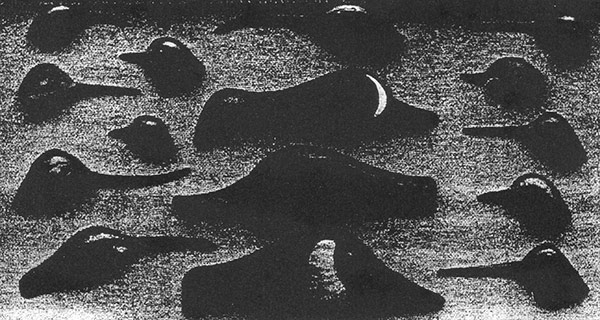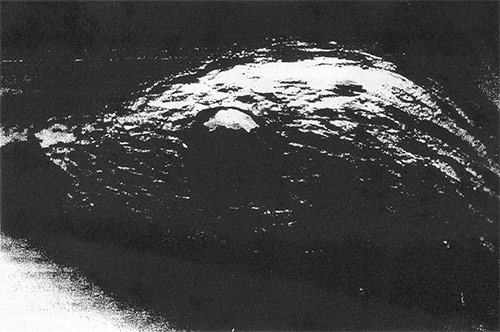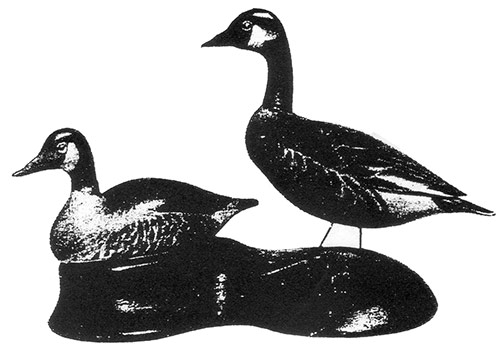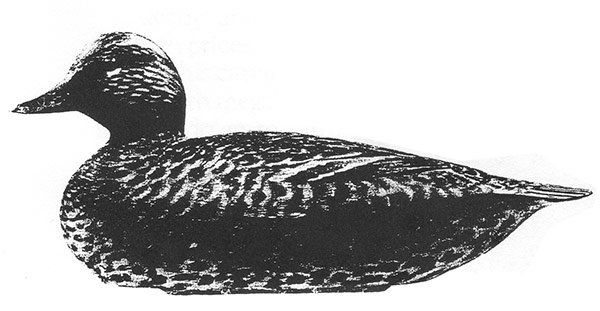DECOYS
Some of Elmer Crowell's decoys are drawing sky-high prices, but not all of his carvings are worth megabucks. Here's a down-to-earth look at the celebrated carver by a man who watched him work.
by John S. duMont • Sporting Classics, 1987
Editor's Note: Although much has been written about Elmer Crowell, one must search long and hard to find in-depth and unbiased reviews of his work. In this guest column, noted decoy expert John S. du Mont recalls his moments with the celebrated carver, who once worked as a gunning stand manager for his family. His insight into Crowell's carving and painting techniques should prove helpful to present day collectors, particularly at a time when big dollars are being spent in the hectic atmosphere of auction rooms. It's a "warts and all" story about the man and his work - his great and not so great. -Alan G. Haid
Elmer Crowell set a record the other day, 34 years after his death. One of his decoys, a rare preening pintail drake, sold for $319,000 to set a new world record in the volatile decoy collecting field — enough to waken Elmer from what is presumed to be a peaceful rest.
Crowell was born in 1862 and it is well known that he worked for some ten years as a gunning stand manager for the noted sportsman and author, Dr. John C. Phillips of Boston. The record-setting pintail was originally made for Dr. Phillips, and while it may have seen some use as a decoy, it was more than likely made as a decorative or mantel bird, to be displayed rather than used.
After he left Dr. Phillips, Crowell was employed for a time as manager of the famous stand at Cliff Pond in East Brewster, Massachusetts. Cliff Pond was owned by my great-uncle and aunt, Mr. and Mrs. Roland C. Nickerson. She was an active gunner who opened one of the first skeet fields in the country. In 1934 Mrs. Nickerson presented Cliff Pond along with a deer pond, several other ponds, and a 1,778-acre forest to the Commonwealth of Massachusetts to be known as Roland C. Nickerson State Forest Park. The family, however, retained the shooting stand and rights.
My father, Horatio S. du Mont, gunned at the stand from the early 1900s until his death. After retirement from business, he served as Massachusetts' Commissioner of Fisheries and Game during Governor Leverett Saltonstall's administration. He met Elmer Crowell and became a lifelong friend. In 1910 Crowell made him a set of six black duck decoys for pothole shooting, charging him a dollar apiece.

Crowell's waterfowl and shorebird heads reflect the same skills found on his mantel birds.
Recognizing Crowell's ability, my father assembled a collection of 21 shorebird and duck heads, some miniatures, and a series of life-size bird carvings. Mother's diary indicates that most of these were collected by 1917.
As a result of my father's sporting activities, I was introduced at an early age to some of the famous Cape Cod market gunners. I also had the opportunity to shoot over live call ducks. My first gunning experience was in the early 1920s on Cape Cod Bay. While I built a seaweed blind, my father set out his black breasted plover folding tin decoys. He then shot (while I shot at) shorebirds.
I went with my father to meet Elmer Crowell in 1931; it was the beginning of a friendship that would last until Crowell gave up carving in 1946. Elmer was very kind to me, always thoughtful and patient. Today when I view his shop, a converted barn which stands on his place at East Harwich, all sorts of memories return: Crowell's calm countenance, chubby face, and bright blue eyes; the smell of cedar shavings and oil paints.
Our family had maintained summer homes at East Brewster from before the tum of the century, so we spent many Thanksgiving, Christmas, and birdshooting holidays there. My father, either at my request or when doing errands, would drop me at Crowell's where I would sit quietly and watching him carve and paint. He never objected. My first carving, at age 12, was a copy of a life-size cock quail that my father had purchased from Crowell. The carving came out fairly well, but the painting was terrible. Back to school at Elmer's.
My wife and I spent our honeymoon on Cape Cod in 1941 and I took her to visit Crowell. I bought a one-third size flying Wilson snipe for $15 and a few miniature ducks at $5 each. We came close to buying a beautiful, life-size drake redhead, carved as "dead game," but agreed that $75 was way beyond on our means - a mistake we have obviously regretted to this day.
After Crowell's death on January 1, 1952, I purchased a life-size bufflehead decorative decoy carved by his son. Cleon S. Crowell, when not working as a plumber, assisted his father by carving from Elmer's pattems.

Crowell used glass eyes for his large carvings, but painted in the eyes on smaller creations.
Elmer Crowell relied on patterns for almost all of his birds. Life-size decoratives of ducks, geese, and shorebirds were mostly based on his patterns of early working decoys. Observe carefully the silhouettes of carvings made from these patterns. Note their attitudes, poses, and how life-like they appear. Shapes such as feeders, sleepers, preeners, flyers, birds with upraised wings, and dead game are rare Crowell styles. Buy them if you can. Even on his working decoys, carved wingtips or incised wings are worthwhile details that reflect superior and extra-grade design.
By the 1930s Crowell was making only a few working decoys. He did some re-paints for customers, but most of his decoy-size ducks were decoratives. Even though the owner with more money than brains could use them for hunting, those who claim they are working decoys don't know what they are talking about. Compared to his contemporaries, Crowell was, and remains, the master of decorative decoys.
Each of his smaller birds, including miniatures, has a small hole in the bottom, sometimes filled with putty. When painting, Crowell would hold up the carving by inserting a stick with a small nail in one end. Some Crowell shorebirds have even larger, putty-filled holes. These birds started out as working decoys, each with a stick attached to the bottom that could be shoved into the sand. Crowell later converted them into mantel birds, complete with legs. Crowell fashioned the legs for his decorative shorebirds from umbrella ribs filled with putty; the feet were also made of putty. I can well remember him rubbing putty between his fingers to produce a delicately-shaped leg or foot.
In his book American Bird Decoys, William F. Mackey Jr. states that Crowell used white pine for his carvings. Truth is, he used native Cape Cod white cedar, though he made some heads out of pine. In my time, his birds were outlined from patterns, cut out on a bandsaw, shaped with a draw shave and knife, filed with a rasp, and then sandpapered to finish. On small birds, he simply painted the eyes; on larger sizes, he used taxidermist glass eyes or painted tacks. Miniatures had painted feet on the base and wire legs.

Crowell carved over 70 different bird species during his career, many as miniatures like these Canada geese.
Crowell recorded his orders in a notebook and completed them in sequence. As his fame spread, he received requests for all kinds of birds. Hunters asked for fine decoys carved and painted in decorative style and not for actual use. Others required songbirds or shorebirds, and before long, sets containing 25 different species were produced for collectors.
Following is a never-before-published list of the bird species he carved:
- Shorebirds — Greater yellowlegs, lesser yellow legs, turnstone, golden plover, upland plover, piping plover, blackbreasted plover, killdeer, dowitcher, purple sandpiper, redback sandpiper, white rump sandpiper, pectoral sandpiper, least peep, marbled godwit, Hudsonian curlew, Jack curlew, sanderling, willen, redbreast, jacksnipe, black-necked stilt, semipalmated plover, sandpiper, spotted sandpiper.
- Songbirds — Baltimore oriole, downy woodpecker, Kentucky warbler, bluejay, nuthatch, towhee, red-headed woodpecker, tree swallow, wood thrush, Tennessee warbler, bluebird, robin, oven bird, kingbird, scarlet tanager, brown thrasher, cedar waxwing, Hicker, Nashville warbler, blue catbird, redwinged blackbird, black-and-white warbler, chickadee, goldfinch, Connecticut warbler.
- Miniature ducks — Mallard, pintail, redhead, bufflehead, ruddy, bluebill, shelldrake, old squaw, canvasback, blue-winged teal, green-winged teal, hooded merganser, goldeneye, brant, wood duck, gooseander, widgeon, black duck, Canada goose.
If Crowell was unfamiliar with a certain species, he would often borrow "flats" or study skins from the old Museum of Natural History on Berkeley Street in Boston. If the museum didn't have what he wanted, he would improvise. Some of his improvised birds were incorrectly painted, such as the piping plover, a shore bird which is now indigenous to New England. The backs of his curlews are often colored like yellowlegs.
Crowell carved in one room of his barn and painted in the other. In later years, he received so many orders for miniatures that he set up something of an assembly line for painting them, just as he had once done with decoys. He often painted five or six at a time. To speed things up, he painted the backs of many ducks the same, even though the plumage of real birds differed greatly. But miniatures were not made to be perfect in every detail. For $5, no one could be asked to create a masterpiece.
Crowell's early decoys were not stamped; to identify these works, you must be able to recognize his carving and painting techniques. In ensuing years he used an oval burned-in stamp; an oval rubber stamp with a touch of modem advertising: "A.E. Crowell, Maker, High Class Decoys of every description, East Harwich, Mass." (used on mantel birds); a paper label; and a rectangular steel stamp which indented the wooden base with: "AE. Crowell, Maker, East Harwich, Mass." He did not mark some of his miniatures. On others he penciled the species name on the base or he signed in ink: "AE. Crowell, Cape Cod. "
After Elmer retired, his son Cleon continued to use the rectangular stamp and the same carving patterns. Collectors must be careful to recognize the son's painting and not pay high prices for something that is not by the master's hand. Late in Elmer's career, both father and son used the rectangular stamp. If given a choice, look for the earlier marks; they are usually superior birds.
Crowell's painting technique is magnificent, particularly on carvings produced up through the 1920s. His detail and accuracy were unbeatable. He did not rush. Comparing early and late examples enables the collector to visualize the differences.
He primed his birds with a heavy coat of white lead, then applied oil paints from the tube or can. Only infrequently did he mix colors, preferring instead to use them just as they came out of the tube. Where he excelled was in blending wet colors, then going over them with a dry brush to produce a feathery texture. No other early decoy maker achieved this effect.
As decoy carvers know, white cedar is popular because of its light weight. Crowell did produce a few hollow decoys, but generally he fashioned them from a solid billet of wood. But cedar has a tendency to crack under dry conditions and it often contains limb knots. Crowell filled these knots with putty and painted over them. Again, under dry conditions, the repairs eventually showed. When carving decorative birds, he was careful to select a superior blank of wood, but in later years when pressed for time, he sometimes used a billet too narrow for a duck body. lnvariably the result fell short of previous standards. However, his triumphs in painting and carving were legion, his mistakes few.

Carved by Elmer Crowell around 1915, this hen green-winged teal fearures carved wingtips, a detail that sets it apart-from the decoys of other early carvers. The bird was created for Dr. John C. Phillips of Beverly, Massachusetts.
Crowell was innovative in many ways. I recall a preening yellow legs holding a carved feather made of tin in its bill. He made a number of flying goose weathervanes and one adorned the peak of his bam. Mrs. Nickerson purchased a Crowell weathervane for her barn. My father copied it and Mrs. Nickerson, a reasonably accomplished artist, painted it. Dad finished a number of these for friends and I often wonder how many are now being sold as original Crowell creations.
A post in front of Crowell's driveway in East Harwich had a full-size hooded merganser on top, advertising his wares. Really a poor choice I thought, as he never made the head of this particular species correctly, probably copying it from a badly-mounted specimen.
And Crowell, undoubtedly at the insistence of his customers, attempted to paint a few bird and fish canvases. The results were horrible. I never have understood how he could paint carvings so well, and make such a childish mess of painting on canvas. Again, collectors have paid huge sums for his paintings, simply because thev were done by Elmer Crowell. How well advised they would have been to spend the same amount of money on a really fine painting by such renowned sporting artists as A. Lassell Ripley or Ogden Pleissner.
Most collectors, after comparing Crowell's work with his contemporaries and later decoy makers, can recognize his superior ability. The results: higher and higher prices. Many carvers today rum out fine, innovative, and lifelike birds, complete with individually carved and inserted feathers. But more is not always better. Painting like Crowell did at the height of his career is rarely seen.
Elmer Crowell created Americana at its best. I doubt that he will ever be surpassed. Still, if you plan to buy a Crowell carving, let Caveat Emptor be your motto. The remarkable upsurge in prices for his work, from $75 in 1940 to $319,000 in 1986, is going to draw flies, so beware. Buy only from a recognized and reliable dealer or auction house that will guarantee authenticity and refund your money if you are not pleased with your purchase. Avoid trying to buy a Crowell at a bargain price unless you are an expert on his methods. In other words, don't try to buy sable for the price of rabbit. Those who do usually wind up with rabbit.
And good luck!
For more on Sporting Classics, visit sportingclassics.com.
Credits
Used with permission of Alan G. Haid, columnist, and Sporting Classics.
Sporting Classics: 1987. 70 - 73. Read Article in PDF »